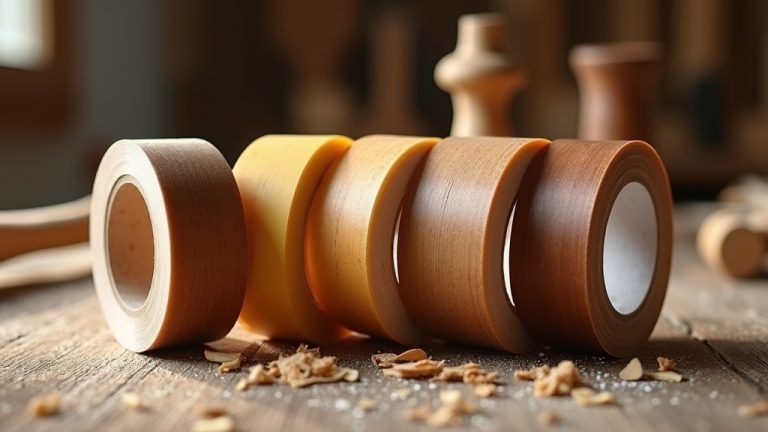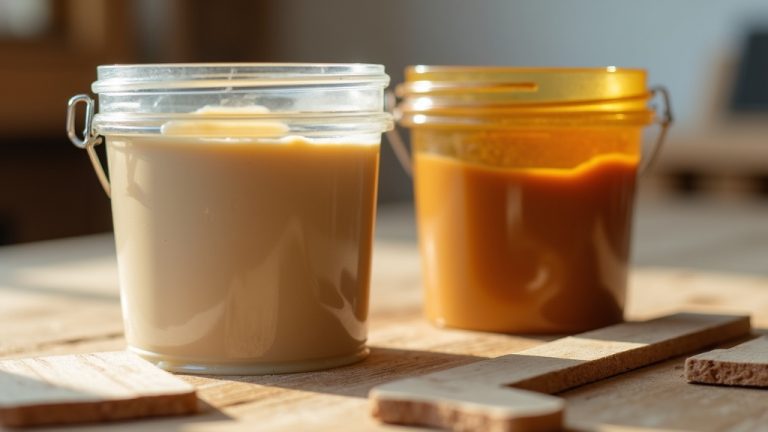White Pine vs Yellow Pine: Key Differences Explained Clearly
If you need lightweight stability and smooth, precise finishes, White Pine’s softer, fine grain and low resin make it ideal for furniture and detailed work.
For strength and rugged durability, especially in structural or outdoor projects, Yellow Pine’s higher density and resin content offer superior load capacity and weather resistance, though it demands more maintenance.
Both are sustainable options. Understanding their differences helps you select the right pine for your specific application and aesthetic needs.
Key Takeaways
- White Pine is softer, lighter, and easier to work with, making it ideal for furniture, paneling, and detailed millwork.
- Yellow Pine is denser, harder, and more durable, suited for structural applications and heavy-use outdoor projects.
- White Pine has a pale, uniform color and fine grain that accepts stains and paints evenly for a smooth finish.
- Yellow Pine features warm golden to reddish tones with coarse grain and prominent knots, offering a rustic, bold aesthetic.
- White Pine is generally less expensive and more widely available in the northeast, while Yellow Pine is common and affordable in the southeast.
Quick Comparison Table for White Pine and Yellow Pine
| Feature | White Pine | Yellow Pine |
|---|---|---|
| Density & Hardness | Lower density, softer (≈380 lbf) | Higher density, harder (≈870–1225 lbf) |
| Color & Aesthetic | Pale, uniform tone, fine grain | Golden to reddish tones, bold grain |
| Knot Characteristics | Smaller, lighter knots, less resin | Larger, darker knots, more resin |
| Workability | Easy to cut, plane, and finish; smooth machining | Tougher on tools, resin may gum blades |
| Stability | Highly stable, less prone to warping | More movement, higher warp potential |
| Outdoor Performance | Requires protection; lower moisture resistance | Better moisture resistance, denser heartwood |
| Finish Behavior | Even stain absorption, ideal for paint | May require sealers to avoid blotching |
| Typical Applications | Furniture, paneling, cabinetry, millwork | Structural framing, decking, heavy-use furniture |
| Availability | Widely available; consistent supply | More regional; common in Southeast U.S. |
| Handling & Weight | Lightweight, easy to maneuver | Heavier, durable under load |
Density and Strength Comparison

Although both White Pine and Yellow Pine are popular softwoods, their density and strength characteristics differ markedly, affecting their suitability for various applications.
Southern Yellow Pine (SYP) has a higher density, averaging 36 to 42 lbs/ft³ (580 to 670 kg/m³), classifying it as a hard pine.
Southern Yellow Pine boasts a density of 36 to 42 lbs/ft³, making it a robust, hard pine.
In contrast, Eastern White Pine averages 22 to 31 lbs/ft³ (350 to 500 kg/m³), making it a soft pine.
This density difference directly impacts strength; Yellow Pine’s Janka hardness reaches approximately 870 lbf (up to 1225 lbf for Heart Pine), providing superior load capacity and durability.
White Pine’s lower hardness rating of about 380 lbf results in easier workability but less resistance to dents and structural stress.
Consequently, Yellow Pine is preferred for demanding structural uses, while White Pine suits interior applications requiring machining ease rather than heavy load-bearing.
Additionally, White Pine is known for its more even grain compared to Yellow Pine, which contributes to its reduced tendency to twist or bow.
Visual Characteristics and Grain Patterns
When you’re deciding between White Pine and Yellow Pine, it’s really important to take a look at their color variations and grain textures.
Yellow Pine has this beautiful range of warm golden to reddish hues, and its grain is quite coarse and uneven. Plus, you’ll notice visible knots that give it that charming, rustic texture. It is also known for its strength and durability, making it ideal for framing and heavy load applications.
On the other hand, White Pine is a bit different. It boasts a lighter and more uniform color, which many people find appealing. Its grain is finer and smoother, and it has fewer knots, which results in a cleaner surface appearance.
Color Variations
The color variations between white pine and yellow pine play a crucial role in their identification and application.
White pine shows a creamy white to pale yellow tone, aging to light golden brown with subtle earlywood and latewood contrast. It is native to the northeastern U.S., which contributes to its softer texture and lighter appearance. Its relatively low density also means it has a lighter design compared to many hardwoods, making it easy to work with.
Yellow pine displays richer, darker hues, golden brown to honey, with more pronounced banding and a greenish tint after treatment. These differences affect stain absorption and final appearance.
White pine offers uniform, pale coloration suited for clear coats and light stains.
Yellow pine features a warmer, uneven color with strong earlywood-latewood contrast.
White pine’s subtle color changes make it ideal for painted or smooth finishes.
Yellow pine’s darker, rustic tones enhance traditional and structural aesthetics.
Knot and Grain Texture
Since knot and grain texture considerably influence wood selection and finishing, understanding their distinctions between white pine and yellow pine is essential. Yellow pine displays darker, rounder knots that are resinous and visually bold. In contrast, white pine’s knots are lighter, softer, and less prominent. The choice of finish can enhance these natural characteristics, with options like penetrating oils providing durable protection that highlights grain and knots.
Yellow pine grain is pronounced, often wavy or irregular, creating a rustic aesthetic. White pine grain appears finer, straighter, and more consistent, offering a smooth, modern look. Texture-wise, yellow pine feels coarser due to larger resin canals. White pine is finer and smoother, ideal for trim and paneling. These characteristics make white pine easy to work with, which is why it is often chosen for furniture and cabinetry.
| Feature | White Pine | Yellow Pine |
|---|---|---|
| Knot Color & Size | Light, soft, smaller | Darker, resinous, larger |
| Grain Pattern | Straight, fine, consistent | Wavy, bold, uneven |
| Texture | Smooth, fine | Coarse, rough |
Durability and Resistance to Weather
When you’re deciding between white pine and yellow pine for your outdoor projects, you really need to think about how well each type stands up to moisture and how long they last.
You see, yellow pine is denser, which means it’s got better moisture resistance. This makes it a champ when it comes to handling wet conditions and outdoor use. In fact, yellow pine scores about 870 on the Janka hardness scale, giving it superior durability compared to white pine.
On the flip side, white pine isn’t as tough when it comes to weathering. You’ll find that it usually needs a bit more care and maintenance if you want it to stick around for the long haul.
Moisture Resistance Comparison
Yellow pine’s higher density and natural resin content give it better moisture resistance and slower water penetration compared to white pine. Proper protective finishes can enhance this natural resistance and extend the lifespan of yellow pine in outdoor applications.
White pine absorbs moisture more rapidly and releases it slowly, increasing the risk of cell damage and decay if untreated.
Both species require protective finishes for prolonged exposure.
Yellow pine’s dense heartwood offers superior resistance to moisture-related decay.
White pine’s softer grain and lower density lead to faster moisture absorption.
Resin in yellow pine provides a mild natural moisture barrier.
Both pines have similar insulation (R-value ~1.12) but yellow pine’s density enhances moisture buffering.
You’ll find yellow pine generally more durable against moisture than white pine.
Fir, however, absorbs 3-4 times less water than pine, making it a more moisture-resistant option overall water absorption comparison.
Outdoor Longevity Factors
Although both white pine and yellow pine can be used outdoors with proper treatment, yellow pine’s superior hardness and density make it considerably more durable against physical wear, dents, and structural stress. Its tighter grain and slower growth contribute to higher load-bearing capacity, supporting longer-lasting structural applications like decking and beams. However, yellow pine is more prone to warping and checking if not installed quickly and properly, especially under conditions of heat and vibration.
In contrast, white pine offers greater dimensional stability and resists warping better, though it’s softer and more susceptible to surface damage and dents under heavy use. White pine also tends to remain straight and stable in applications, reducing waste.
Both woods weather to distinct rustic appearances and require preservative treatments to enhance resistance, but yellow pine tends to retain a greenish tint from these treatments longer.
Your choice should balance durability needs with stability and aesthetic preferences.
Ease of Workability and Finishing
Because White Pine is softer and has lower resin content than Yellow Pine, you’ll find it markedly easier to cut, plane, and shape with hand or power tools. This softness reduces tool wear and minimizes tear-out, allowing smoother, more precise work. Its lightweight and stable nature also helps reduce warping during the crafting process, making it a reliable choice for detailed woodworking projects. Lightweight and stable Additionally, White Pine’s compatibility with 1/2″ bandsaw blades enhances its ease of cutting for intricate designs.
When finishing, White Pine’s fine grain and low resin promote even absorption of stains and paints, requiring less surface preparation.
White Pine’s Janka hardness (~380 lbf) contrasts with Yellow Pine’s higher range (~870–1225 lbf), influencing tool sharpness needs.
Yellow Pine’s resin can gum blades, complicating cutting and shaping.
White Pine accepts stains uniformly, while Yellow Pine often needs sealers to avoid blotches.
You’ll spend less time sanding White Pine due to its smoother surface texture.
Cost Differences and Market Availability

When comparing white pine and yellow pine, cost and availability hinge largely on their growth rates and regional supply.
White pine grows faster, making it more abundant and generally less expensive, especially in the northeastern U.S. Yellow pine’s slower growth, particularly longleaf varieties, limits supply and raises prices, often requiring reclaimed sources. Proper cutting techniques using a fine-toothed blade can help preserve the quality of pine wood during woodworking projects.
Regional availability varies: white pine is widespread, while yellow pine is concentrated in the southeast and less common elsewhere. Softwoods like yellow pine are often heavy, cheap, and readily available at lumberyards, making them an excellent value for structural use.
| Aspect | White Pine |
|---|---|
| Growth Rate | Fast |
| Availability | Widespread in North America |
| Typical Price Range | $2.50–$3.25 per board foot |
| Market Sources | New and reclaimed stocks |
| Aspect | Yellow Pine |
| Growth Rate | Slow |
| Availability | Southeast U.S., limited elsewhere |
| Typical Price Range | $0.78+ per board foot, premium for reclaimed |
| Market Sources | New limited, reclaimed common |
Typical Applications in Construction and Furniture
When you’re choosing wood for construction, yellow pine really stands out. Its high density and load-bearing capacity make it a top choice for structural applications, perfect for framing and anything that needs to hold up under pressure. Southern yellow pine is known for its strength and durability, making it ideal for long-term structural use. Its versatility also allows it to be used in a variety of projects, from outdoor decking to heavy-use furniture.
On the other hand, you’ve got white pine, which is softer and more dimensionally stable. This makes it a great option for non-structural elements like paneling or lightweight framing. White pine’s ease of workability is a benefit when precision and accuracy are needed in crafting detailed pieces.
Now, when it comes to furniture making, white pine shines with its smooth grain and ease of shaping. It’s really ideal for decorative and finely finished pieces.
But if you need something more robust, yellow pine is your go-to. It’s perfect for heavy-use furniture that needs to withstand a lot of wear and tear. Using the right tools, such as a table saw, can enhance the precision and quality of furniture construction with yellow pine.
Structural Uses Comparison
Although both white pine and yellow pine find roles in construction and furniture, their structural uses differ markedly due to variations in density and strength.
Yellow pine’s higher density and Janka hardness (870 vs. 380) give it superior load-bearing capacity, making it ideal for critical framing elements. It also allows for longer spans due to its higher strength-to-weight ratio. Additionally, yellow pine’s higher strength makes it a preferred choice for applications demanding durability and stability.
White pine, being lighter and less dense, suits lighter framing and non-load-bearing applications.
When choosing between them, consider these points:
Yellow pine supports longer spans for joists, rafters, and beams with fewer supports.
White pine requires closer spacing or larger dimensions for similar loads.
Pressure-treated yellow pine excels in exterior and moisture-prone environments.
White pine is preferred for interior, dry applications emphasizing ease of handling.
This structural disparity guides their use in construction and heavy-duty scenarios.
Furniture Suitability Differences
Since furniture demands both aesthetic appeal and functional durability, choosing between white pine and yellow pine depends largely on their grain characteristics, workability, and wear resistance.
White pine’s fine, straight grain and light color suit modern, painted finishes and detailed cabinetry due to its softness and ease of machining. You’ll find it ideal for intricate designs requiring precision and smooth staining. Additionally, white pine is lightweight and easy to handle, which benefits craftsmen focusing on detailed work. When preparing white pine for furniture, it is important to sand carefully along the grain to avoid grain raising and achieve a smooth finish.
Conversely, yellow pine’s pronounced grain and warm hues lend a rustic, traditional look, appealing for robust furniture like cabinets and chests. Its higher density offers superior dent resistance, making it better for high-traffic pieces.
However, yellow pine’s resin content challenges machining and finishing. For moisture-prone environments, yellow pine’s greater stability and resistance reduce warping risks, while white pine needs careful sealing to maintain integrity over time. Proper sanding techniques and finishing with food-safe oils can enhance yellow pine’s durability and appearance.
Impact of Resin Content on Maintenance
Because yellow pine contains markedly more resin than white pine, maintaining its surfaces demands greater attention and specialized care. You’ll find that resin pockets in yellow pine cause uneven stain absorption and sticky buildup, complicating cleaning and refinishing processes.
This is because yellow pine is characterized by a higher density and abrupt earlywood-latewood transition, which contributes to its resin content and grain unevenness. Regular maintenance not only preserves the wood’s appearance but also enhances tool longevity when working on the surface.
White pine’s minimal resin allows for easier staining and finishing, reducing maintenance effort.
When working with yellow pine, consider these key maintenance factors:
- Resin buildup requires frequent removal using solvent-based cleaners.
- Sandpaper clogs faster due to resin, increasing abrasive replacement frequency.
- Specialized sealers are necessary to prevent uneven staining.
- Resin migration risks finish degradation, demanding careful surface preparation.
Understanding resin’s impact helps you select appropriate products and techniques for each wood type’s upkeep.
Stability and Tendency to Warp or Crack
Resin content not only affects maintenance but also influences the stability of pine species.
White pine’s low pitch content and even texture grant it superior dimensional stability, making it less prone to warping or cracking. Its minimal movement under humidity changes ensures straightness, favoring precision woodworking, paneling, and decorative applications.
Additionally, white pine exhibits a decent strength-to-weight ratio, contributing to its versatility in indoor projects.
Conversely, southern yellow pine’s higher density and resin pockets increase susceptibility to warping and cracking, especially without proper drying or acclimation.
This leads to greater dimensional movement, causing gaps or misalignment in flooring and paneling.
Yellow pine’s tendency to warp raises waste factors during installation, while its cracking often results from rapid moisture fluctuations.
Environmental and Sustainability Considerations
While choosing between white pine and yellow pine, you should consider their environmental and sustainability aspects. These impact both forest health and the long-term availability of resources.
Both species come from managed forests employing sustainable practices, including reforestation and certification systems like FSC. Their rapid growth rates facilitate quicker replenishment and lower environmental footprints per wood volume.
Additionally, both contribute to carbon sequestration by storing carbon in standing forests and wood products, aiding climate mitigation.
Southern Yellow Pine forests use prescribed burns to sustain ecosystem health and biodiversity.
White Pine requires careful site selection to avoid stress and pests, ensuring sustainable yields. It is sensitive to factors such as soil type, moisture extremes, and root disturbance, which can lead to White Pine Decline.
Both species benefit from mixed plantings to enhance genetic diversity and resilience.
Local sourcing reduces transportation emissions, enhancing environmental benefits.
Choosing Between White Pine and Yellow Pine for Your Project
When selecting between white pine and yellow pine for your project, you’ll need to evaluate their mechanical properties and workability to match your specific requirements.
Choose yellow pine if strength, durability, and resistance to wear are critical, such as in flooring, decking, or structural framing. Its higher Janka hardness (870+) and density make it ideal for high-traffic or ground-contact applications. However, it demands sharper tools and careful handling to avoid warping. Southern yellow pine, in particular, is known for its distinct growth layers that contribute to its toughness and bold figure.
Conversely, white pine offers superior dimensional stability and ease of machining. This makes it suited for furniture, cabinetry, and intricate millwork. It’s softer and lighter, so it’s less durable under heavy use but excels in carving and finishing.
Consider availability and finish preferences: white pine provides consistent color and workability, while yellow pine delivers a bold, rustic aesthetic with more variable grain.
Frequently Asked Questions
How Do White Pine and Yellow Pine Differ in Fire Resistance?
You’ll find that Yellow Pine has thicker, corky bark that insulates it during fires, making it more fire-resistant than White Pine.
Yellow Pines also drop lower branches and produce fire-resistant cones, helping them survive and recover from surface fires.
In contrast, White Pine has thinner bark and lacks these adaptations, so it’s more vulnerable to heat damage and fire mortality.
You’ll notice White Pine doesn’t regenerate as effectively post-fire either.
Are There Differences in Allergenic Reactions to White Pine Versus Yellow Pine?
You’ll find allergic reactions to both white pine and yellow pine pollen are rare and typically mild, with no significant difference between them.
Both produce large, heavy pollen grains that don’t disperse far, reducing airborne exposure.
Studies show most people with tree pollen allergies react to hardwoods or grasses, not pines.
Can White Pine or Yellow Pine Be Used for Musical Instruments?
You can use both white and yellow pine for musical instruments, but each affects tone and durability differently.
White pine, being soft and lightweight, gives a mellower, glassier sound ideal for folk instruments or solid-body guitars. However, it dents easily.
Yellow pine’s hardness provides better wear resistance and potentially brighter sustain, suiting solid-body electrics.
You’ll need to weigh tonal goals, handling, and longevity when choosing between them for your instrument projects.
How Do the Scents of White Pine and Yellow Pine Compare?
You’ll find white pine offers a milder, cleaner pine scent due to its smaller resin canals and lower resin content, producing subtle woody and earthy notes.
Yellow pine, with larger resin canals and higher resin levels, delivers a stronger, warmer, and more resinous aroma rich in terpenes.
Its scent is bolder and lingers longer, often preferred for rustic or aromatic applications.
White pine suits situations needing a gentler, less overpowering pine fragrance.
Which Pine Type Is Better for Carving and Sculpting Projects?
Imagine crafting a detailed wooden figurine.
You’ll find white pine better for carving and sculpting because its low hardness (Janka 380) and fine grain let you shape intricate details with less tool wear.
Its uniform texture and low resin content guarantee smooth finishes and easier staining.
Yellow pine’s hardness offers durability but makes fine carving tougher.
Make the Right Choice Based on Your Project Goals
When choosing between white pine and yellow pine, consider your project’s specific needs: strength, appearance, or durability. You might worry that white pine lacks robustness, but its stability and ease of finishing often outweigh that concern in interior applications.
Conversely, yellow pine’s density suits structural uses, though it can be harder to work with. Evaluating factors like resin content, cost, and environmental impact guarantees you select the best wood, balancing performance and sustainability effectively.







